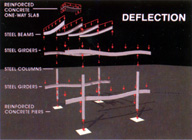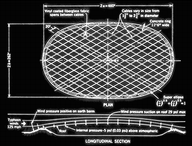
As published in Civil Engineering Magazine, January 1996, pp 16 - 18.
Right now, about 80 Columbia architecture and engineering students are using Webster's networked multimedia volumes in classes, and he is helpng orchestrate a major expansion for next year. Develpment costs for the Farnsworth portion of the project ran around $30,000, which includes complete Powerpoint and Showcase versions for classroom use on PCs and Silicon Graphics computers, as well as a complete Netscape version running on the Internet from PCs, Apple Macintoshes or Unix-based machines. Webster plans to expand the project by develpoing a comprehensive interdisciplinary multimedia analysis of major American post-World War II covered stadiums as well as unusual, innovative small buildings like the Farnsworth House and the PATCenter.
So far the project has received funding from the National Science
Foundation's Gateway Engineering Coalition, the National Endowment for the
ARts and the Columbia provost's Strategic Initiative Fund. The system is
also being used on an experimental basis at Drexel University and Ohio
State University. According to Webser, director of building technologies
at Columbia's Graduate School of Architecture, the program will expand to
encompass International Services Digital Network videoconferencing next
spring. Via this real-time conferencing system, students in Webster's
class exploring the engineering aspects of the U.S. Pavilion at Expo 70
will benefit from having Bill Spillers, chairman of the civil engineering
department at the New Jersey Institute of Technology and an expert in
lightweight, long-spand pneumatic structures, "in the class and
participating in our discussion of the building,: Webster says. Spillers
will also provide a Larsa-based nonlinear analysis of the roof on the
Internet site.
"This is the greatest thing since sliced bread," exclaims Webster, tongue
firmly in cheek, "To me, the prject is very significant because its
digital tool set allows building-science students and scholars to learn a
variety of interdisciplary information much more quickly than they could
by relying on traditional media."

